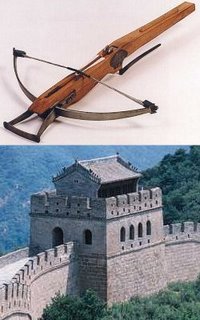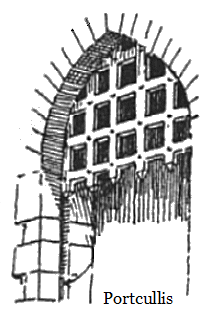May 28, 2006Part 17 (12 Kingdoms) Chapter 68 Chapter 68The stirrup of a crossbow is the D-shaped metal strap attached to the nose to hold the crossbow down while the bowstring is drawn back. Chapter 67 The guard tower described in this chapter follows the same design as those found on the Great Wall of China. Note the alternating merlons and crenels lining the roof. Chapter 65 I've changed my mind several times about the translation of shishi (師士), a nonstandard kanji compound. Etymologically, it means "master samurai" or "teacher samurai." ("Shishi" is also a homophone for "lion.") Based on the context, I've translated it as "praetorian." To quote from Wikipedia: "The term Praetorian came from the tent of the commanding general or praetor of a Roman army in the field—the praetorium. It was a habit of many Roman generals to choose from the ranks a private force of soldiers to act as bodyguards  of the tent or the person. For the praetorians, saving Shoukou is a matter of self-interest, as opposed to the provincial guard, who aren't eager to get killed propping up a corrupt governor. of the tent or the person. For the praetorians, saving Shoukou is a matter of self-interest, as opposed to the provincial guard, who aren't eager to get killed propping up a corrupt governor.An allure or wall walk is the walkway behind the parapet of a castle wall. Chapter 64 籍恩 [せきおん] Seki On 1. 主恩 [しゅおん] shuon, a gift from one's master 2. 殊恩 [しゅおん] shuon, a very special gift 3. 誅恩 [ちゅうおん] chuuon, lit. "executioner's gift" There's some clever punning going on with the kanji in these words. The constant is the second character (on), meaning "gift." 2 is the kanji left on the walls of Shoukou's residence. Shoukou reads these kanji to mean 3.
Comments: Assuming I've counted correctly (the author doesn't number the chapters sequentially, but by book/part/chapter; the sequential chapter numbers are for my own convenience), it comes to 80 chapters, an afterword, and a short postscript, or a total of 81.1 chapters.
|
